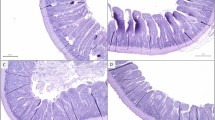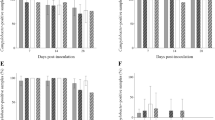Abstract
Although a high number of chickens carry Campylobacter jejuni, the mechanistic action of colonization in the intestine is still poorly understood. The current study was therefore designed to investigate the effects of C. jejuni on glucose uptake, amino acids availability in digesta, and intracellular calcium [Ca2+]i signaling in the intestines of broiler chickens. For this, we compared: control birds (n = 60) and C. jejuni-infected birds (n = 60; infected orally with 1 × 108 CFU of C. jejuni NCTC 12744 at 14 days of age). Our results showed that glucose uptake was reduced due to C. jejuni infection in isolated jejunal, but not in cecal mucosa at 14 days postinfection (dpi). The decrease in intestinal glucose absorption coincided with a decrease in body weight gain during the 2-week post-infectious period. A reduction in the amount of the amino acids (serine, proline, valine, leucine, phenylalanine, arginine, histidine, and lysine) in ileal digesta of the infected birds at 2 and/or 7 dpi was found, indicating that Campylobacter utilizes amino acids as a carbon source for their multiplication. Applying the cell-permeable Ca2+ indicator Fluo-4 and two-photon microscopy, we revealed that [Ca2+]i was increased in the jejunal and cecal mucosa of infected birds. The muscarinic agonist carbachol induced an increase in [Ca2+]i in jejunum and cecum mucosa of control chickens, a response absent in the mucosa of infected chickens, demonstrating that the modulation of [Ca2+]i by Campylobacter might be involved in facilitating the necessary cytoskeletal rearrangements that occur during the bacterial invasion of epithelial cells. In conclusion, this study demonstrates the multifaceted interactions of C. jejuni with the gastrointestinal mucosa of broiler chickens. For the first time, it could be shown that a Campylobacter infection could interfere with intracellular Ca2+ signaling and nutrient absorption in the small intestine with consequences on intestinal function, performance, and Campylobacter colonization. Altogether, these findings indicate that Campylobacter is not entirely a commensal and can be recognized as an important factor contributing to an impaired chicken gut health.


Similar content being viewed by others
References
Awad WA, Aschenbach JR, Setyabudi FMCS, Razzazi-Fazeli E, Böhm J, Zentek J (2007a) In vitro effects of deoxynivalenol on small intestinal d-glucose uptake and absorption of deoxynivalenol across the isolated jejunal epithelium of laying hens. Poult Sci 86:15–20
Awad WA, Razzazi-Fazeli E, Böhm J, Zentek J (2007b) Influence of deoxynivalenol on the d-glucose transport across the isolated epithelium of different intestinal segments of laying hens. J Anim Physiol Anim Nutr 91:175–180
Awad WA, Razzazi-Fazeli E, Böhm J, Zentek J (2008) Effects of B-trichothecenes on luminal glucose transport across the isolated jejunal epithelium of broiler chickens. J Anim Physiol Anim Nutr 92:225–230
Awad WA, Ghareeb K, Böhm J (2011a) Evaluation of the chicory inulin efficacy on ameliorating the intestinal morphology and modulating the intestinal electrophysiological properties in broiler chickens. J Anim Physiol Anim Nutr (Berl) 95:65–72
Awad WA, Vahjen W, Aschenbach JR, Zentek J (2011b) A diet naturally contaminated with the Fusarium mycotoxin deoxynivalenol down regulates gene Expression of glucose transporters in the intestine of broiler chickens. Livestock Sci 140:72–79
Awad WA, Aschenbach JR, Khayal B, Hess C, Hess M (2012) Intestinal epithelial responses to Salmonella enterica serovar Enteritidis: effects on intestinal permeability and ion transport. Poult Sci 91:2949–2957
Awad WA, Aschenbach JR, Ghareeb K, Khayal B, Hess C, Hess M (2014a) Campylobacter jejuni influences the expression of nutrient transporter genes in the intestine of chickens. Vet Microbiol 172:195–201
Awad WA, Ghareeb K, Zentek J (2014b) Mechanisms underlying the inhibitory effect of the feed contaminant deoxynivalenol on glucose absorption in broiler chickens. Vet J 202:188–190
Awad WA, Hess C, Khayal B, Aschenbach JR, Hess M (2014c) In vitro exposure to Escherichia coli decreases ion conductance in the jejunal epithelium of broiler chickens. PLoS ONE 9:e92156. doi:10.1371/journal.pone.0092156
Awad WA, Molnár A, Aschenbach JR, Ghareeb K, Khayal B, Hess C, Liebhart D, Dublecz K, Hess M (2015) Campylobacter infection in chickens modulates the intestinal epithelial barrier function. Innate Imm 21:151–160
Bierne H, Dramsi S, Gratacap MP, Randriamampita C, Carpenter G, Payrastre B, Cossart P (2000) The invasion protein InIB from Listeria monocytogenes activates PLC-gamma1 downstream from PI 3-kinase. Cell Microbiol 2:465–476
Binder HJ (1989) In: Sleisenger MH, Fordtran JS (eds) Gastrointestinal disease: pathophysiology, diagnosis management, vol 2, 4th edn. W. B. Saunders, Philadelphia, pp 1022–1044
Chaloner G, Wigley P, Humphrey S, Kemmett K, Lacharme-Lora L, Humphrey T, Williams N (2014) Dynamics of dual infection with Campylobacter jejuni strains in chickens reveals distinct strain-to strain variation in infection ecology. Appl Environ Microbiol 80:6366–6372
Dean P, Maresca M, Schüller S, Phillips AD, Kenny B (2006) Potent diarrheagenic mechanism mediated by the cooperative action of three enteropathogenic Escherichia coli-injected effector proteins. Proc Natl Acad Sci U S A 103:1876–1881
Dhillon AS, Shivaprasad HL, Schaberg D, Wier F, Weber S, Bandli D (2006) Campylobacter jejuni infection in broiler chickens. Avian Dis 50:55–58
Donowitz M, Welsh MJ (1987) Regulation of mammalian small intestinal electrolyte secretion. In: Johnson LR (ed) Physiology of the gastrointestinal tract, 2nd edn. Raven Press, New York, pp 1351–1388
Ghareeb K, Awad WA, Mohnl M, Schatzmayr G, Böhm J (2013) Control strategies for Campylobacter infection in poultry production. World’s Poult Sci J 69:57–76
Gharib-Naseri K, Rahimi S, Khaki P (2012) Comparison of the effects of probiotic, organic acid and medicinal plant on Campylobacter jejuni challenged broiler chickens. J Agr Sci Tech 14:1485–1496
Guccione E, Leon-Kempis Mdel R, Pearson BM, Hitchin E, Mulholland F, van Diemen PM, Stevens MP, Kelly DJ (2008) Amino acid-dependent growth of Campylobacter jejuni: key roles for aspartase (AspA) under microaerobic and oxygen-limited conditions and identification of AspB (Cj0762), essential for growth on glutamate. Mol Microbiol 69:77–93
Hendrixson DR, DiRita VJ (2004) Identification of Campylobacter jejuni genes involved in commensal colonization of the chick gastrointestinal tract. Mol Microbiol 52:471–484
Hermans D, Van Deun K, Martel A, Van Immerseel F, Messens W, Heyndrickx M, Haesebrouck F, Pasmans F (2011) Colonization factors of Campylobacter jejuni in the chicken gut. Vet Res 42:82–96
Hofreuter D, Novik V, Galan JE (2008) Metabolic diversity in Campylobacter jejuni enhances specific tissue colonization. Cell Host Microbe 4:425–433
Hofreuter D, Mohr J, Wensel O, Rademacher S, Schreiber K, Schomburg D, Gao B, Galán JE (2012) Contribution of amino acid catabolism to the tissue specific persistence of Campylobacter jejuni in a murine colonization model. PLoS ONE 7:e50699
Hu L, Kopecko DJ (2000) Interactions of Campylobacter with eukaryotic cells: gut luminal colonization and mucosal invasion mechanisms. In: Nachamkin I, Blaser MJ (eds) Campylobacter, 2nd edn. American Society for Microbiology, Washington, DC, pp 191–215
Hu L, Raybourne RB, Kopecko DJ (2005) Ca2+ release from host intracellular stores and related signal transduction during Campylobacter jejuni 81-176 internalization into human intestinal cells. Microbiology 151:3097–3105
Humphrey T (2006) Are happy chickens safer chickens? Poultry welfare and disease susceptibility. Brit Poult Sci 47:379–391
Humphrey S, Chaloner G, Kemmett K, Davidson N, Williams N, Kipar A, Humphrey T, Wigley P (2014) Campylobacter jejuni is not merely a commensal in commercial broiler chickens and affects bird welfare. mBio 5:e01364–e01414
Kanwar RK, Ganguly NK, Kumar L, Rakesh J, Panigrahi D, Walia BN (1995) Calcium and protein kinase C play an important role in Campylobacter jejuni-induced changes in Na+ and Cl− transport in rat ileum in vitro. Biochim Biophys Acta 1270:179–192
Lam KM, DaMassa AJ, Morishita TY, Shivaprasad HL, Bickford AA (1992) Pathogenicity of Campylobacter jejuni for turkeys and chickens. Avian Dis 36:359–363
Lamb-Rosteski J, Kalischuk L, Douglas Inglis G, Buret G (2008) Epidermal growth factor inhibits Campylobacter jejuni-induced claudin-4 disruption, loss of epithelial barrier function, and Escherichia coli translocation. Infect Immun 76:3390–3398
Mace OJ, Lister N, Morgan E, Shepherd E, Affleck J, Helliwell P, Bronk JR, Kellett GL, Meredith D, Boyd R, Pieri M, Bailey PD, Pettcrew R, Foley D (2009) An energy supply network of nutrient absorption coordinated by calcium and T1R taste receptors in rat small intestine. J Physiol 587:195–210
Maresca M, Mahfoud R, Garmy N, Kotler DP, Fantini J, Clayton F (2003) The virotoxin model of HIV-1 enteropathy: involvement of GPR15/Bob and galactosylceramide in the cytopathic effects induced by HIV-1 gp120 in the HT-29-D4 intestinal cell line. J Biomed Sci 10:156–166
Norris V, Grant S, Freestone P, Canvin J, Sheikh FN, Toth I, Trinei M, Modha K, Norman RI (1996) Calcium signalling in bacteria. J Bacteriol 178:3677–3682
Ousingsawat J, Mirza M, Tian Y, Roussa E, Schreiber R, Cook DI, Kunzelmann K (2011) Rotavirus toxin NSP4 induces diarrhea by activation of TMEM16A and inhibition of Na+ absorption. Pflugers Arch - Eur J Physiol 461:579–589
Parsons CM, Potter LM, Brown JRD (1983) Effects of dietary carbohydrate and of intestinal microflora on excretion of endogenous amino acids by poultry. Poult Sci 62:483–489
Ruiz-Palacios GM, Escamilla E, Torres M (1981) Experimental Campylobacter diarrhea in chickens. Infect Immun 34:250–255
Solis de los Santos F, Donoghue AM, Venkitanarayanan K, Reyes-Herrera I, Metcalf JH, Dirain ML, Aguiar VF, Blore PJ, Donoghue DJ (2008) Therapeutic supplementation of caprylic acid in feed reduces Campylobacter jejuni colonization in broiler chicks. Appl Environ Microbiol 74:4564–4566
Tran Van Nhieu G, Clair C, Grompone G, Sansonetti P (2004) Calcium signalling during cell interactions with bacterial pathogens. Biol Cell 96:93–101
Van Deun K, Pasmans F, Ducatelle R, Flahou B, Vissenberg K, Martel A, Van den Broeck W, Van Immerseel F, Haesebrouck F (2008) Colonization strategy of Campylobacter jejuni results in persistent infection of the chicken gut. Vet Microbiol 130:285–297
Vegge CS, Brøndsted L, Li YP, Bang DD, Ingmer H (2009) Energy taxis drives Campylobacter jejuni toward the most favorable conditions for growth. Appl Environ Microbiol 75:5308–5314
Velayudhan J, Jones MA, Barrow PA, Kelly DJ (2004) l-Serine catabolism via an oxygen-labile l-serine dehydratase is essential for colonization of the avian gut by Campylobacter jejuni. Infect Immun 72:260–268
Wang MY, Tsai MY, Wang C (1994) Identification of chicken liver glucose transporter. Arch Biochem Biophys 310:172–179
Williams LK, Sait LC, Trantham EK, Cogan TA, Humphrey TJ (2013) Campylobacter infection has different outcomes in fast- and slow-growing broiler chickens. Avian Dis 57:238–241
Acknowledgments
This work was financed within the Center of Excellence for Poultry (CEPO) project, which is funded by the European Regional Development Fund, Cross-border Cooperation Programme Austria–Hungary 2007–2013. Grant No: L00112. Furthermore, the authors gratefully thank the Alexander von Humboldt Foundation, Bonn, Germany, for supporting Wageha Awad as a visiting Fellowship for experienced researchers to the Free University of Berlin, Germany. Finally, we would like to thank all staff who assisted with the animal infection experiments at the Clinic for Poultry and Fish Medicine, Vienna.
Ethics statement
The animal experiment was approved by the institutional ethics committee of the University of Veterinary Medicine and the Ministry of Research and Science under license number GZ 68.205/0011-11/3b/2013. This study was performed in strict accordance to the European Union and Austria’s regulations for the use and care of animals. All husbandry practices were performed with full consideration of animal welfare.
Conflict of interest
None
Author information
Authors and Affiliations
Corresponding author
Rights and permissions
About this article
Cite this article
Awad, W.A., Smorodchenko, A., Hess, C. et al. Increased intracellular calcium level and impaired nutrient absorption are important pathogenicity traits in the chicken intestinal epithelium during Campylobacter jejuni colonization. Appl Microbiol Biotechnol 99, 6431–6441 (2015). https://doi.org/10.1007/s00253-015-6543-z
Received:
Revised:
Accepted:
Published:
Issue Date:
DOI: https://doi.org/10.1007/s00253-015-6543-z




